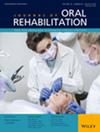Determining the Effect of Video Information on the Dental Anxiety Levels of the Endodontic Patients: A Randomised Clinical Trial
Abstract
Objective
The present study assessed the effectiveness of pretreatment education in the form of Visual Video Information (VVI) on the anxiety levels of patients during endodontic treatment steps.
Methods
Patients (n = 120) having single-rooted teeth with a single root canal diagnosed with asymptomatic irreversible pulpitis and/or pre-prosthetic root canal treatment were included in this study. After completing anxiety scales and a sociodemographic/dental habits survey, the patients were randomly divided into two groups. Just before the endodontic treatment, VVI was given to the video group patients, while the control group patients received routine information verbally. In both groups, a galvanic skin response (GSR) device was placed on the patients' wrists to record the stress levels during the endodontic treatment process. Anxiety scales and a feedback-satisfaction survey were administered to all patients after the treatment process. Then, statistical analysis was performed (α = 0.05).
Results
This study performed 60 endodontic treatments on 60 patients (30 females and 30 males). Sociodemographic characteristics and dental treatment habits of the patients significantly affected dental anxiety scale scores (p < 0.05). VVI resulted in a significant decrease in the mean scores of anxiety before and after the treatment, but this decrease was not significant between the groups (p > 0.05). Similarly, VVI did not impact the GSR readings between the groups during treatment (p > 0.05).
Conclusions
The educational VVI is effective for reducing anxiety in patients undergoing endodontic treatment. In addition, the electrodermal activity method is a promising alternative for objectively assessing anxiety levels.


 求助内容:
求助内容: 应助结果提醒方式:
应助结果提醒方式:


